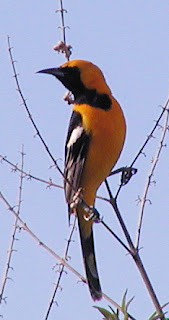 |
| Male Bullocks Oriole |
We tend to put birds into categories based mainly upon their diet:
- Birds of prey (hawks and owls) get a totally positive rating for their service eating varmints.
- Insectivores and seed eaters (various flycatchers, doves, goldfinches, quail, robins and hummingbirds) get a positive rating for eating insects or seeds and mostly avoiding orchard fruit.
- Voracious fruit eaters (blue Jays, orioles, house finches, starlings, sparrows) get either a mixed or negative rating due to bad manners, eating too much fruit, and generally being a pest. Of course not all birds are necessarily completely good or bad. Our Bullocks orioles are about the most dramatically colored birds around and always a treat to watch, but I'd like them better if they didn't eat our fruit.
 |
| A barn owl peeks out of his home |
Owls are some of our favorites, especially barn owls. These beautiful creatures have our undying gratitude for solving our serious gopher problem some years ago. Barn owls nest only in cavities (hollow trees, old buildings, or man made nest boxes) so several years ago I installed several boxes on our property and around the area to entice more owls to settle here.
 |
| Seven young barn owls in their nest box |
Now we enjoy the comforting sounds of barn owls at night year-round, knowing they are on the job keeping rodent pests in check. You can see more of our owl photos in this post.
Besides barn owls, great horned owls, screech owls, and burrowing owls inhabit the neighborhood. And a variety of hawks take over varmint hunting duties during the day.
 |
| A male bluebird sits outside a nest box |
 |
| A bluebird enjoys a drink from the birdbath |
As we have encouraged beneficial birds with nest boxes, bird baths and a diversity of food sources, we've noticed an increase in their numbers compared to pest birds. But we still have plenty of fruit eaters that require elaborate bird scare contraptions during harvest season - more on that when the time comes. In the meantime we're just enjoying the sights and sounds of our feathered friends.
 |
| A goldfinch frolics in the bath |
 |
| Acorn woodpecker |
 |
| A dove sits patiently in her nest |
Bless you! How wonderful to see all those owl kids, teenagers and adults thriving, thanks to the boxes you've put up! Owls are extremely rare in Munich by now - in the half century I've lived here I've seen all of one wild owl - a magnificent horned owl - twenty years ago.
ReplyDeleteYour photos are marvelous - the intense blue and red of the bluebird
Will tell a dear family friend up near Sevastopol your encouraging news about owls decimating gophers - he told me his terrain is like a Swiss cheese by now, more holes than cheese.
Lindsay
Lindsay